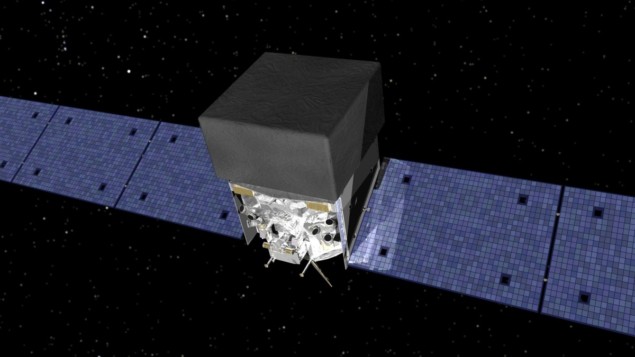
Ultra-relativistic neutrinos blasted into space during gamma-ray bursts are slowed down by the effects of quantum gravity. That is the conclusion of physicists in Italy, Poland and Norway, who have spotted seven neutrinos that arrived on Earth later than expected, compared to their companion gamma rays.
Quantum theory does a fantastic job of describing interactions that involve three out of the four known forces of nature. However, there is no theory today that adequately describes the quantum nature of gravity. While theories of quantum gravity have been proposed, they tend to make predictions that cannot currently be tested by experiment or observation.
One prediction that physicists have a chance of confirming today is that particles moving very near to the speed of light will lose energy because of a quantum gravitational effect. The faster the particle is moving, the more the effect is enhanced. While the effect is extremely small, if the particles are created in an astrophysical event billions of light-years away, the cumulative result would be a delay that could be measured when the particles arrive on Earth.
Late neutrinos
Now, a team led by Giovanni Amelino-Camelia of the University of Naples have looked for this effect in neutrino data collected by the IceCube Neutrino Observatory. Located at the South Pole, the observatory detects neutrinos when they occasionally interact within a cubic kilometre of ice.
The researchers identified seven neutrinos that have high probabilities of coming from gamma-ray bursts. These are highly energetic events that are produced either by the supernovae of the most massive stars, or by colliding neutron stars. Gamma rays from these specific bursts were also detected by NASA’s Fermi Gamma-ray Space Telescope.
Tantalizingly, these neutrinos appear to have arrived at Earth up to three days after the gamma rays were detected, suggesting that something had delayed them. The three-day delay is expected of particles with energies up to 500 TeV. In comparison, neutrinos with higher energies up to 2 PeV would require a 12-day delay window, which is too long to positively identify them with a specific gamma-ray burst.
Amelino-Camelia explains: “The particles get this extra contribution to their speed, which is negative, and it grows in magnitude as their energy grows”.
Location, location
However, not everyone is convinced. Teppei Katori of Kings College London, who was not involved in the work, points out that the seven candidate neutrinos are all of the “cascade-type”. In a cascade event, a neutrino enters the IceCube Observatory and deposits all of its energy into a small, spherical region, making it difficult to determine the direction that the neutrino came from. This is unlike a “track event”, which produces a signal that points back to the neutrino’s point of origin in the cosmos.
“We don’t know where these neutrinos are coming from exactly,” explains Katori.
Indeed, it is not even clear that gamma-ray bursts do produce a significant number of neutrinos. Katori cites earlier work describing a search for neutrinos from gamma-ray bursts that failed to find a correlation between the two. However, he accepts that this search did not take into account any delays caused by quantum-gravity effects.
In 2022 Katori – who is part of the IceCube collaboration – was a science lead on another experiment looking for quantum gravity effects in neutrinos. Specifically, this study looked at how quantum gravity could affect neutrino oscillations.
Neutrinos come in three different “flavours” – electron, muon and tau – and the particles can oscillate from one flavour to another. Although the experiment found no evidence for quantum gravity affecting neutrino oscillations, it was the first experiment to probe these oscillations at a level where quantum gravity should be relevant. As such, the experiment was able to impose constraints on quantum-gravity models that predict variations in the oscillations.
Implications for cosmology
If quantum gravity is indeed slowing down neutrinos, both Amelino-Camelia and Katori agree that the observation would be a major step forward in understanding quantum gravity and its role in the evolution of the universe.
However, Amelino-Camelia points out, “If the effect is only there for neutrinos and other half-integer spin particles, then the implications for cosmology might be minor.”

Quantum gravity could soon be tested using ultracold atoms
For Katori, the most significant outcome of confirming a delay is that physicists could use it to calculate the size of the quantum gravity effect. This would allow physicists to evaluate competing models of quantum gravity – and to take the next step and design experiments and observatories to measure the effect more precisely.
“There is still a gap between quantum-gravity-motivated phenomenology models and quantum-gravity theories,” says Katori. “I think filling this gap is challenging [but] finding any quantum-gravity-motivated effect is the first step.”
The search for neutrinos from gamma-ray bursts will benefit from the construction of IceCube-Gen2, which will increase the size of the detector volume to eight cubic kilometres of ice, improving the ability of the observatory to pinpoint the origins of neutrinos.
The research is described in Nature Astronomy.
- SEO Powered Content & PR Distribution. Get Amplified Today.
- PlatoData.Network Vertical Generative Ai. Empower Yourself. Access Here.
- PlatoAiStream. Web3 Intelligence. Knowledge Amplified. Access Here.
- PlatoESG. Automotive / EVs, Carbon, CleanTech, Energy, Environment, Solar, Waste Management. Access Here.
- BlockOffsets. Modernizing Environmental Offset Ownership. Access Here.
- Source: https://physicsworld.com/a/is-quantum-gravity-slowing-down-neutrinos/



